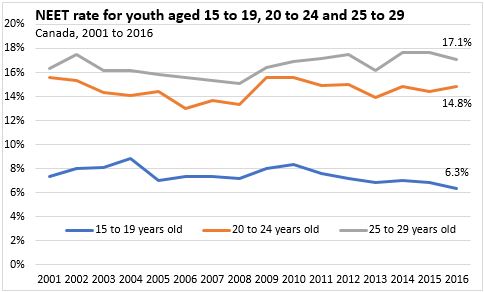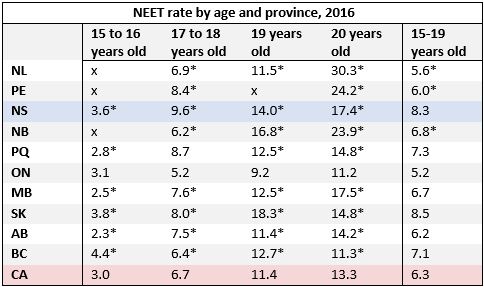The Economics and Statistics Division maintains archives of previous publications for accountability purposes, but makes no updates to keep these documents current with the latest data revisions from Statistics Canada. As a result, information in older documents may not be accurate. Please exercise caution when referring to older documents. For the latest information and historical data, please contact the individual listed to the right.
<--- Return to Archive
For additional information relating to this article, please contact:
March 06, 2018STUDY: THE TRANSITION FROM SCHOOL TO WORK – THE NOT IN EMPLOYMENT, EDUCATION OR TRAINING (NEET) INDICATOR FOR 15 TO 19 YEAR OLDS IN CANADA, 2016 Statistics Canada has released a study which explores the education and labour market situation of young Canadians aged 15 to 19 using the NEET indicator.
The NEET indicator is the proportion of young people aged 15 to 29 who are not in employment, education or training. This study is the first of three, and looks specifically at the group 15 to 19 to understand school and labour market transitions for Canadian youth. Future studies will examine the age groups 20 to 24 and 25 to 29.
In 2016, the NEET rate in Canada (not including the territories) was 6.3% for youth aged 15 to 19, close to the OECD average of 6.1%. NEET rates for this age group have been declining in Canada since 2010. This can be explained by the increasing proportion of youth age 15 to 19 staying in school. In 2004 only 79% of youth aged 15 to 19 were in school compared to 83% in 2016. Older age groups (20 to 29) tend to have higher NEET rates than the 15 to 19 age group.

There are some differences in the NEET rates for young men and women. Young men had a NEET rate of 7.2% in 2016, higher than that for young women (5.4%). The difference reflects the fact that women are less likely to have left school to join the labour force, while men are more likely to be out of school and have entered the labour force.
Across OECD countries, the NEET rate for 15 to 19 year olds varied from a low of 2.1% in the Czech Republic to a high of 18.4% in Turkey. This study also examines two characteristics of a country’s education system that might explain these differences – the ending age of compulsory education and the typical age of high-school graduation. There is no clear relationship between the 15 to 19 NEET rate and the ending age of compulsory education. However, there seems to be a relationship between the typical age of high-school graduation and the NEET rate. The NEET rate for aged 15 to 19 tends to be lower in countries that have a higher typical age of high-school graduation. This reflects the local labour market requirements or social expectations for educational attainment.
Youth between the ages of 15 and 19 vary in terms of education and labour market status. In Canada, schooling is mandatory till age 16 in most provinces, while the typical age of high-school graduation is 17-18. Those aged 15 to 16 are generally still in the process of completing their high-school education, and those 17 to 20 are in the process of transitioning out of school and into the labour market. Because of these differences, the age 15 to 19 indicator is limited in what it can tell us about potentially at risk youth.
With this in mind, the study then looked closer at the 15 to 19 age group and showed it contained two sub-groups around the age of high-school graduation – 15 to 16 and 17 to 19. In Canada in 2016, the NEET rate for ages 15-16 was only 3%, with most not yet graduated high-school. NEET youth in this age group may be of concern because they would not have high-school credentials and have not left school to join the labour market. Between the ages of 17 and 18 the high-school graduation rate rises sharply and the NEET rate also increases at a similar pace. A higher proportion of youth aged 17 to 20 are out of school and either have entered or are attempting to enter the labour market.

Across the provinces, there are generally no statistically significant differences in NEET rates for any age group. This means that the observed differences between the NEET rates could be because of sampling variability and not actual differences in the provincial rates. In Nova Scotia, the NEET rate for 15 to 19 year olds was 8.3% in 2016. In the finer age groups, rates should be interpreted with caution as there is high sampling variability associated with the estimates.

Note: x = suppressed to meet the confidentiality requirements of the Statistics Act
* use with caution.
Source: Statistics Canada, Daily Release | Full Report
This report is part of the Education Indicators in Canada: Fact Sheet series (Catalogue number 81-599-X)
<--- Return to Archive